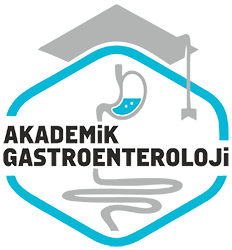Agustos 2009
Helikobakter pilori eradikasyonu reflü semptomlarini ve endoskopik özofajiti olumlu etkiliyor
The eradication of Helicobacter pylori positively influences symptoms of reflux and endoscopic eosophagitis
- Ana Sayfa
- Sayılar
- Agustos 2009
- Helikobakter pilori eradikasyonu reflü semptomlarini ve endoskopik özofajiti olumlu etkiliyor...
Dr Lütfi Kirdar Kartal Egitim ve Arastirma Hastanesi, Gastroenteroloji Klinigi2, Istanbul
Özet
Giriş ve Amaç: Helikobakter pilori infeksiyonu ile gastroözofageal reflü hastalığı arasındaki ilişki kismen açiklanmasina ragmen, Helikobakter pilori eradikasyon tedavisinin, basarili olsun veya olmasin reflü semptomatolojisi üzerindeki etkisi halen tartismalidir. Bu çalışmada Helikobakter pilori eradikasyon tedavisinin reflü semptom skoru ve endoskopik özofajit üzerindeki etkisi arastirildi. Gereç ve Yöntem: çalışmaya ortalama yaşlari 43.3±10.9 yıl olan, 245 Helikobakter pilori infeksiyonlu olgu alinmıştır. Özofagus darligi ve tümörü, gastrik ülser, gastrik tümör ve gastrik çikis obstrüksiyonu olan olgular çalışma dışı bırakıldı. Her olguda tedavi öncesi ve sonrasi reflü semptomları sorgulandi. Gastroskopi (bazal-3 ay sonra) yapilarak endoskopik özofajit şiddeti Los Angeles skoruna göre değerlendirildi. Helikobakter pilori pozitifliği gastroskopide alinan 2 antrum, 2 korpus biyopsi örneğinin histopatolojik olarak değerlendirilmesi ile arastirildi. Histopatolojik olarak Helikobakter pilori negatif ise eradikasyon basarili kabul edildi. Olgularin tedavi öncesi ve sonrasi reflü semptomları, endoskopik özofajit varligi, Helikobakter pilori varligi ve yokluguna göre karsilastirildi. Bulgular: Tüm olgular değerlendirildiginde; tedavi öncesinde reflü semptomu orani %59.8 iken; tedavi sonrasinda %15.9?a gerilemisti (p<0.01). Helikobakter pilori eradikasyonu saglananlarda, reflü semptomu olanlar, tedavi öncesinde %60.1 iken; tedavi sonrasinda %13.3 idi (p<0.01). Helikobakter pilori eradikasyonu saglanamayanlarda da tedavi öncesinde reflü semptomu olanlar %58.3 iken; tedavi sonrasinda %22.2?ye gerilemekte idi (p<0.01). Endoskopik özofajit tüm olgular değerlendirildiginde; tedavi öncesinde %15.1 iken; tedavi sonrasinda %9.8?e gerilemıştır (p<0.05). Helikobakter pilori eradikasyonu saglananlarda; tedavi öncesinde özofajitliler %16.2 iken; tedavi sonrasinda bu oran %8.1 bulunmustur (p<0.01). Sonuç: Helikobakter pilori eradikasyonu reflü semptomlarında ve endoskopik özofajit sikliginda anlamli azalmaya neden olmaktadır. Eradikasyon saglanamayanlarda ise anlamli olmamakla birlikte endoskopik özofajitte artma görülmüstür. Bunun yani sira semptomlarda azalmanin görülmesi Helikobakter pilori yogunlugunun azalmasina bagli olabilecegi seklinde yorumlanmıştır. Basarili Helikobakter pilori eradikasyonunun hem reflü semptomları hem de endoskopik özofajit üzerine olumlu etkisi olduğu söylenebilir.
Abstract
Background and Aims: Despite the fact that the relationship between Helicobacter pylori (H. pylori) infection and gastroesophageal reflux disease has been partially delineated, the influence of H. pylori eradication treatment on reflux symptoms is still controversial regardless of its success. In this study, we investigated the effects of H. pylori eradication treatment on reflux symptom score and endoscopic esophagitis. Materials and Methods: Two hundred forty-five patients with H. pylori infection with a mean age of 43.3±10.9 years were included in the study. Exclusion criteria were the presence of gastric tumors, ulcers, esophageal strictures, and tumors. Each patient was interviewed for reflux symptoms before and after the treatment. By performing a gastroscopy (basal and 3 months later), the severity of endoscopic esophagitis was evaluated according to LA score. H. pylori positivity was analyzed by obtaining two biopsy samples from the antrum and two from the corpus during gastroscopy and examining them histopathologically. The eradication was deemed successful if H. pylori was (-) in histopathological examination. The reflux symptoms before and after the treatment were compared with regards to the presence or absence of esophagitis and H. pylori. Results: When all the patients were evaluated, the frequency of reflux symptoms was 59.8% before treatment and regressed to 15.9% after treatment (p<0.01). This significant regression was not found to be in relation with the success of H. pylori eradication. Among those in whom H. pylori eradication was achieved, the frequency of reflux symptoms was 60.1% before the treatment and 13.3% after the treatment (p<0.01). Among the patients in whom H. pylori eradication could not be achieved, the frequency of reflux symptoms was 58.3% before the treatment and 22.2% after the treatment (p<0.01). When all patients were evaluated, endoscopic esophagitis was 15.1% before treatment and 9.8% after treatment (p<0.05). Among those with successful H. pylori eradication, the frequency of esophagitis before treatment was 16.2% and this was reduced to 8.1% after the treatment (p<0.01). Conclusions: Eradication of H. pylori results in a significant decrease in reflux symptoms and the frequency of endoscopic esophagitis. In those in whom eradication was not possible, there was an increase in endoscopic esophagitis despite not reaching statistical significance. The observed decrease in the symptoms might be interpreted as the effect of the decrease in H. pylori density. We can therefore claim that successful H. pylori eradication has positive effects on both reflux symptoms and endoscopic esophagitis.



